Beyond Barriers: Constructing the Cloud Migration Complexity Index for China’s Digital Transformation
Abstract
:1. Introduction
2. Literature Review
2.1. Cloud Migration
2.2. Complexity Measurement
2.3. Cloud Computing and Enterprise Digitalization
3. The Cloud Migration Complexity Index
3.1. BPMN for Business Service Deployment
- Non-cloud: Businesses need to complete the entire process from power supply, hardware layout, and server procurement to operating system installation and service deployment. This involves manually installing systems, configuring networks, and setting up required services on each server. While automation tools can simplify the deployment and configuration processes, the environment for these tools must be first be configured, including initializing the network, storage, and permissions on all physical servers. Additionally, since different services (e.g., SLB load balancers, application servers, and database servers) have varying deployment requirements, businesses need to write customized configuration files for each service to ensure alignment with the standard deployment model. For load balancers, application servers, and databases, high availability is considered, meaning these components are deployed in pairs.
- IaaS: Businesses utilize Alibaba Cloud’s ECS for servers and Alibaba’s SLB for load balancing. Configured servers can be quickly cloned using features provided by cloud service providers. While automation tools can simplify the configuration of application and database servers, these tools still require initial setup. However, SLB configuration can be managed directly on the Alibaba Cloud platform, which simplifies the process compared to using automation tools.
- PaaS: Businesses use Alibaba Cloud’s Serverless App Engine (SAE) and RDS, which offer managed environments for running applications and databases, thereby reducing manual configuration. SAE simplifies high-availability setups for application servers by allowing automatic scaling through simple adjustments to server quantities on the platform. Similarly, RDS makes it easy to create high-availability database instances during the instance creation process. These tools replace the need for automation tools used in non-cloud and IaaS environments, significantly streamlining the deployment process.
- SaaS: Due to the nature of SaaS, there is no need for specific server-level deployment or configuration. Businesses focus primarily on customization based on their specific needs, configuring the system and importing data into an already-completed platform [55]. This reduces the complexity of deployment and shifts the emphasis to application-level configurations that align with business requirements.
3.2. Complexity Measurement of Business Deployment
3.2.1. Method of Measurement
3.2.2. Assignment of Technical Weight
- Specialized Technical Skills (Knowledge): The technical skills required to complete tasks, primarily ICT-related skills. Specific items refer to those listed in the ESCO (European Skills, Competences, Qualifications, and Occupations) [58].
- Complex Operations (Operations): Tasks that involve complex operational processes, such as executing more than five operating system commands, writing complex configuration files for tools, or performing operations that span multiple hosts or platforms.
- Rich Experience (Experience): The experience or soft skills needed to complete tasks, such as management and financial skills or proficiency in configuring and operating specific public cloud platforms.
| for all tasks of PM do TW of task is assigned to 1 if specific technical knowledge is required do TW of task increments by TW(Knowledge) end if complex operations are required do TW of task increments by TW(Operations) end if rich experience is required do TW of task increments by TW(Experience) end end |
3.2.3. Post-Processing of Measurement Results
3.3. Measurement of Cloud Migration Complexity Index
4. Theoretical Framework
5. Research Design
5.1. Model Construction
5.2. Variable Description
5.2.1. Dependent Variable
5.2.2. Independent Variables
5.2.3. Control Variables
5.3. Sample and Data Description
5.3.1. Research Sample and Data Source
5.3.2. Descriptive Statistics of Variables
6. Results
6.1. Baseline Regression
6.2. SMEs and Non-SMEs
7. Discussion
7.1. The Trend of Cloud Computing and Migration Complexity
7.2. Cloud Migration Complexity and Enterprise Digitization
8. Conclusions
Author Contributions
Funding
Institutional Review Board Statement
Informed Consent Statement
Data Availability Statement
Conflicts of Interest
Appendix A
| Task_id | Knowledge | Operations | Experience | TW |
|---|---|---|---|---|
| 1 | ICT infrastructure | None | Business management | 3 |
| 2 | ICT infrastructure | None | Budget management | 3 |
| 3 | Network engineering, power engineering | None | None | 3 |
| 4 | Network engineering | None | None | 2 |
| 5–10 | Operating systems, network engineering | Operating system commands | None | 4 |
| 11 | Operating systems, DevOps | Operating system commands, configure automation tool | None | 5 |
| 12–17 | Operating systems, DevOps | Operating system commands, cross-server interaction | None | 6 |
| 18 | DevOps, database, SQL | Writing and executing automation scripts, configuring master–slave replication, cross-server interaction | None | 7 |
| 19 | DevOps, web services | Writing and executing automation scripts, cross-server interaction | None | 5 |
| 20 | DevOps, proxy servers, network engineering | Writing and executing automation scripts, cross-server interaction | None | 6 |
| 21 | Monitoring tools, operating systems, ICT infrastructure | Configuring specific monitoring targets, cross-server interaction | Incident management | 7 |
| Task_id | Knowledge | Operations | Experience | TW |
|---|---|---|---|---|
| 1 | None | None | None | 1 |
| 2 | None | None | None | 1 |
| 3 | Network engineering, ICT infrastructure, operating systems | None | Cloud platform configuration | 4 |
| 4 | None | None | None | 1 |
| 5 | Operating systems, network engineering | None | Cloud platform configuration | 4 |
| 6 | Operating systems, DevOps | Operating system commands, configure automation tool | None | 5 |
| 7 | Operating systems, DevOps | Operating system commands, cross-server interaction | None | 5 |
| 8 | None | None | Cloud platform configuration | 2 |
| 9 | DevOps, database, SQL | Writing and executing automation scripts, configuring master–slave replication, cross-server interaction | None | 7 |
| 10 | DevOps, web services | Writing and executing automation scripts, cross-server interaction | None | 5 |
| 11 | Proxy servers, network engineering | None | Cloud platform configuration | 4 |
| 12 | Cloud monitoring and reporting, operating systems, ICT infrastructure | None | Cloud platform configuration, incident management | 6 |
| Task_id | Knowledge | Operations | Experience | TW |
|---|---|---|---|---|
| 1 | None | None | None | 1 |
| 2 | None | None | None | 1 |
| 3 | None | None | None | 1 |
| 4 | Web services | None | Cloud platform configuration | 3 |
| 5 | None | None | None | 1 |
| 6 | ICT infrastructure, database | None | Cloud platform configuration | 4 |
| 7 | SQL | None | None | 2 |
| 8 | None | Configure application | None | 2 |
| 9 | None | None | Cloud platform configuration | 2 |
| 10 | Network engineering | None | Cloud platform configuration | 3 |
| 11 | Cloud monitoring and reporting | None | Cloud platform configuration, incident management | 4 |
| Task_id | Knowledge | Operations | Experience | TW |
|---|---|---|---|---|
| 1 | None | None | None | 1 |
| 2 | None | None | None | 1 |
| 3 | Web services | None | None | 2 |
| 4 | Business intelligence | None | None | 2 |
| 5 | None | None | Cloud platform configuration | 2 |
| 6 | None | None | None | 1 |
Appendix B
| Dimension | Keywords |
|---|---|
| Artificial intelligence technology | artificial intelligence, machine learning, deep learning, intelligent robot, natural language processing, cognitive computing, brain-like computing, intelligent data analysis, image interpretation, face recognition, speech recognition, biometric technology, automatic driving |
| Big data technology | big data, data mining, text mining, data visualization, business intelligence, semantic search, heterogeneous data |
| Security technology | authentication, blockchain, multi-party security computing, differential privacy technology |
| Virtual reality technology | augmented reality, mixed reality, virtual reality |
| Cloud computing technology | cloud computing, stream computing, graph computing, memory computing, distributed computing, fusion architecture, hundred million concurrence, EB level storage, green computing |
| Internet of things technology | the Internet of things, smart wear, smart home, Internet connection, information physics system |
| Financial technology | investment decision support system, credit investigation, digital currency, Internet finance, digital finance, Fintech, financial technology, quantitative finance, open banking |
| Internet business models | mobile Internet, industrial Internet, internet medical, E-commerce, B2B, B2C, C2B, C2C, O2O |
| Payment methods | mobile payment, third-party payment, NFC payment |
| Digital technology applications | smart energy, smart agriculture, smart transportation, smart medical, smart customer service, smart culture and tourism, smart environmental protection, smart grid, smart marketing, digital marketing, unmanned retail, smart building |
References
- Mithas, S.; Tafti, A.; Bardhan, I.; Goh, J.M. Information technology and firm profitability: Mechanisms and empirical evidence. Mis Q. 2012, 36, 205–224. [Google Scholar] [CrossRef]
- Verhoef, P.C.; Broekhuizen, T.; Bart, Y.; Bhattacharya, A.; Dong, J.Q.; Fabian, N.; Haenlein, M. Digital transformation: A multidisciplinary reflection and research agenda. J. Bus. Res. 2021, 122, 889–901. [Google Scholar] [CrossRef]
- Venters, W.; Whitley, E.A. A critical review of cloud computing: Researching desires and realities. J. Inf. Technol. 2012, 27, 179–197. [Google Scholar] [CrossRef]
- Mell, P.; Grance, T. The NIST Definition of Cloud Computing (Draft). NIST Spec. Publ. 2011, 800, 145. [Google Scholar]
- Bhardwaj, S.; Jain, L.; Jain, S. Cloud computing: A study of infrastructure as a service (IAAS). Int. J. Eng. Inf. Technol. 2010, 2, 60–63. [Google Scholar]
- Gill, S.S.; Tuli, S.; Xu, M.; Singh, I.; Singh, K.V.; Lindsay, D.; Tuli, S.; Smirnova, D.; Singh, M.; Jain, U. Transformative effects of IoT, Blockchain and Artificial Intelligence on cloud computing: Evolution, vision, trends and open challenges. Internet Things 2019, 8, 100118. [Google Scholar] [CrossRef]
- Beheshti-Atashgah, M.; Aref, M.R.; Barari, M.; Bayat, M. Security and privacy-preserving in e-health: A new framework for patient. Internet Things 2020, 12, 100290. [Google Scholar] [CrossRef]
- Sultan, N. Cloud computing for education: A new dawn? Int. J. Inf. Manag. 2010, 30, 109–116. [Google Scholar] [CrossRef]
- Low, C.; Chen, Y.; Wu, M. Understanding the determinants of cloud computing adoption. Ind. Manag. Data Syst. 2011, 111, 1006–1023. [Google Scholar] [CrossRef]
- Shuaib, M.; Samad, A.; Alam, S.; Siddiqui, S.T. Why adopting cloud is still a challenge?—A review on issues and challenges for cloud migration in organizations. Ambient Commun. Comput. Syst. RACCCS-2018 2019, 904, 387–399. [Google Scholar]
- Zhang, G.; Ravishankar, M.N. Exploring vendor capabilities in the cloud environment: A case study of Alibaba Cloud Computing. Inf. Manag. 2019, 56, 343–355. [Google Scholar] [CrossRef]
- Abolhassan, F. The drivers of digital transformation. In Why There’s No W. Around Cloud; Springer: Cham, Switzerland, 2017. [Google Scholar]
- Leimeister, S.; Böhm, M.; Riedl, C.; Krcmar, H. The Business Perspective of Cloud Computing: Actors, Roles and Value Networks. In Proceedings of the ECIS 2010 Proceedings, Pretoria, South Africa, 7–9 June 2010; Volume 56. [Google Scholar]
- Kwilinski, A.; Litvin, V.; Kamchatova, E.; Polusmiak, J.; Mironova, D. Information support of the entrepreneurship model complex with the application of cloud technologies. Int. J. Entrep. 2021, 25, 1–8. [Google Scholar]
- Mohammed, C.M.; Zeebaree, S.R.M. Sufficient comparison among cloud computing services: IaaS, PaaS, and SaaS: A review. Int. J. Sci. Bus. 2021, 5, 17–30. [Google Scholar]
- Surya, L. Software as a service in cloud computing. Int. J. Creat. Res. Thoughts (IJCRT) ISSN 2019, 7, 182–186. [Google Scholar]
- von Rosing, M.; White, S.; Cummins, F.; de Man, H. Business Process Model and Notation-BPMN. In The Complete Business Process Handbook; von Rosing, M., von Scheel, H., Scheer, A.-W., Eds.; Morgan Kaufmann: Burlington, MA, USA, 2014; pp. 433–457. [Google Scholar]
- Chinosi, M.; Trombetta, A. BPMN: An introduction to the standard. Comput. Stand. Interfaces 2012, 34, 124–134. [Google Scholar] [CrossRef]
- Michael Kavis, M.K. Architecting the Cloud Design Decisions for Cloud Computing Service Models; Wiley Online Library: Hoboken, NJ, USA, 2014; ISBN 1118617614. [Google Scholar]
- Buyya, R.; Srirama, S.N.; Casale, G.; Calheiros, R.; Simmhan, Y.; Varghese, B.; Gelenbe, E.; Javadi, B.; Vaquero, L.M.; Netto, M.A.S. A manifesto for future generation cloud computing: Research directions for the next decade. ACM Comput. Surv. 2018, 51, 1–38. [Google Scholar] [CrossRef]
- Ransome, J.W.R.J.F. Cloud Computing Implementation, Management, and Security; CRC Press: Boca Raton, FL, USA, 2010. [Google Scholar]
- Ullah, R.M.U.; Buckley, K.; Garvey, M.; Li, J. Cloud Computing Adoption in Enterprise: Challenges and Benefits. Int. J. Comput. Trends Technol. 2019, 67, 93–104. [Google Scholar] [CrossRef]
- da Silva, F.S.; Nascimento, M.H.R. Major Challenges Facing Cloud Migration. ITEGAM-JETIA 2020, 6, 59–65. [Google Scholar]
- Carcary, M.; Doherty, E.; Conway, G. The adoption of cloud computing by irish smes an exploratory study. Electron. J. Inf. Syst. Eval. 2014, 17, 3–14. [Google Scholar]
- Li, Z.; O’brien, L.; Zhang, H.; Cai, R. On a catalogue of metrics for evaluating commercial cloud services. In Proceedings of the 2012 ACM/IEEE 13th International Conference on Grid Computing (GRID’12), Beijing, China, 20–23 September 2012; IEEE Computer Society: Washington, DC, USA, 2012; pp. 164–173. [Google Scholar]
- Alkhalil, A.; Sahandi, R.; John, D. An exploration of the determinants for decision to migrate existing resources to cloud computing using an integrated TOE-DOI model. J. Cloud Comput. 2017, 6, 2. [Google Scholar] [CrossRef]
- Abdelkader, K.; Aki, R.; Yedder, S.; Arfa, R. Challenges and Factors Affecting Cloud Computing Adoption in Higher Technical Education Institutions in Libya. In Proceedings of the 2021 IEEE 1st International Maghreb Meeting of the Conference on Sciences and Techniques of Automatic Control and Computer Engineering MI-STA, Tripoli, Libya, 25–27 May 2021; pp. 310–315. [Google Scholar]
- Ali, O.; Shrestha, A.; Ghasemaghaei, M.; Beydoun, G. Assessment of complexity in cloud computing adoption: A case study of local governments in Australia. Inf. Syst. Front. 2021, 24, 595–617. [Google Scholar] [CrossRef]
- Dumas, M.; La Rosa, M.; Mendling, J.; Reijers, H.A. Fundamentals of Business Process Management; Springer: Berlin/Heidelberg, Germany, 2018; Volume 2. [Google Scholar]
- Bag, S.; Wood, L.C.; Mangla, S.K.; Luthra, S. Procurement 4.0 and its implications on business process performance in a circular economy. Resour. Conserv. Recycl. 2020, 152, 104502. [Google Scholar] [CrossRef]
- Beerepoot, I.; Di Ciccio, C.; Reijers, H.A.; Rinderle-Ma, S.; Bandara, W.; Burattin, A.; Calvanese, D.; Chen, T.; Cohen, I.; Depaire, B. The biggest business process management problems to solve before we die. Comput. Ind. 2023, 146, 103837. [Google Scholar] [CrossRef]
- Gruhn, V.; Laue, R. Adopting the cognitive complexity measure for business process models. In Proceedings of the 2006 5th IEEE International Conference on Cognitive Informatics, Beijing, China, 17–19 July 2006; Volume 1, pp. 236–241. [Google Scholar]
- Vanderfeesten, I.; Cardoso, J.; Mendling, J.; Reijers, H.A.; Van der Aalst, W. Quality metrics for business process models. BPM Work. Handb. 2007, 144, 179–190. [Google Scholar]
- Yaqin, M.A.; Sarno, R.; Rochimah, S. Measuring scalable business process model complexity based on basic control structure. Int. J. Intell. Eng. Syst. 2020, 13, 52–65. [Google Scholar] [CrossRef]
- Yaqin, M.A.; Sarno, R.; Fauzan, A.C. Scalability measurement of business process model using business processes similarity and complexity. In Proceedings of the 2017 4th International Conference on Electrical Engineering, Computer Science and Informatics (EECSI), Yogyakarta, Indonesia, 19–21 September 2017; pp. 1–7. [Google Scholar]
- Lăcătușu, M.; Ionita, A.D.; Anton, F.D.; Lăcătușu, F. Analysis of complexity and performance for automated deployment of a software environment into the cloud. Appl. Sci. 2022, 12, 4183. [Google Scholar] [CrossRef]
- Zhou, C.; Zhang, D.; Chen, D.; Liu, C. A Change-Sensitive Complexity Measurement for Business Process Models Based on Control Structure. Systems 2023, 11, 250. [Google Scholar] [CrossRef]
- Al Hadwer, A.; Tavana, M.; Gillis, D.; Rezania, D. A systematic review of organizational factors impacting cloud-based technology adoption using Technology-organization-environment framework. Internet Things 2021, 15, 100407. [Google Scholar] [CrossRef]
- Dillon, T.; Wu, C.; Chang, E. Cloud computing: Issues and challenges. In Proceedings of the 2010 24th IEEE International Conference on Advanced Information Networking and Applications, Perth, Australia, 20–23 April 2010; pp. 27–33. [Google Scholar]
- Rashid, A.; Chaturvedi, A. Cloud computing characteristics and services: A brief review. Int. J. Comput. Sci. Eng. 2019, 7, 421–426. [Google Scholar] [CrossRef]
- Bataev, A.V.; Rodionov, D.G.; Andreyeva, D.A. Analysis of world trends in the field of cloud technology. In Proceedings of the 2018 International Conference on Information Networking (ICOIN), Chiang Mai, Thailand, 10–12 January 2018; pp. 594–598. [Google Scholar]
- Kilcioglu, C.; Rao, J.M.; Kannan, A.; McAfee, R.P. Usage patterns and the economics of the public cloud. In Proceedings of the 26th International Conference on World Wide Web, Perth, Australia, 3–7 April 2017; pp. 83–91. [Google Scholar]
- Kraus, S.; Jones, P.; Kailer, N.; Weinmann, A.; Chaparro-Banegas, N.; Roig-Tierno, N. Digital transformation: An overview of the current state of the art of research. Sage Open 2021, 11, 21582440211047576. [Google Scholar] [CrossRef]
- Eller, R.; Alford, P.; Kallmünzer, A.; Peters, M. Antecedents, consequences, and challenges of small and medium-sized enterprise digitalization. J. Bus. Res. 2020, 112, 119–127. [Google Scholar] [CrossRef]
- Gunturu, N.M. A Framework for Successful Corporate Cloud Transformation. arXiv 2023, arXiv:2304.05333. [Google Scholar]
- Wang, C.; Zhang, M. The road to change: Broadband China strategy and enterprise digitization. PLoS ONE 2022, 17, e0269133. [Google Scholar] [CrossRef] [PubMed]
- Zhang, T.; Shi, Z.-Z.; Shi, Y.-R.; Chen, N.-J. Enterprise digital transformation and production efficiency: Mechanism analysis and empirical research. Econ. Res. Ekon. Istraživanja 2022, 35, 2781–2792. [Google Scholar]
- Cloud Computing White Paper. 2022. Available online: http://www.caict.ac.cn/kxyj/qwfb/bps/202207/P020220721643085625934.pdf (accessed on 16 July 2023).
- Alibaba Cloud. Best Practices for Deploying a Typical Business Website. 2020. Available online: https://resource.alibabacloud.com/bestpractice/detail.html?spm=a3c0i.7911826.6791778070.737.6d8d3870T3TW7B&bpId=2020082619340700001 (accessed on 16 July 2023).
- Somasekaram, P.; Calinescu, R.; Buyya, R. High-availability clusters: A taxonomy, survey, and future directions. J. Syst. Softw. 2022, 187, 111208. [Google Scholar] [CrossRef]
- Gholami, M.F.; Daneshgar, F.; Low, G.; Beydoun, G. Cloud migration process—A survey, evaluation framework, and open challenges. J. Syst. Softw. 2016, 120, 31–69. [Google Scholar]
- Aydin, H. A study of cloud computing adoption in universities as a guideline to cloud migration. Sage Open 2021, 11, 21582440211030280. [Google Scholar] [CrossRef]
- Eckerson, W.W. Performance Dashboards: Measuring, Monitoring, and Managing Your Business; John Wiley & Sons: Hoboken, NJ, USA, 2010. [Google Scholar]
- Faustino, J.; Adriano, D.; Amaro, R.; Pereira, R.; da Silva, M.M. DevOps benefits: A systematic literature review. Softw. Pract. Exp. 2022, 52, 1905–1926. [Google Scholar] [CrossRef]
- Benlian, A.; Hess, T.; Buxmann, P. Drivers of SaaS-adoption—An empirical study of different application types. Bus. Inf. Syst. Eng. 2009, 1, 357–369. [Google Scholar] [CrossRef]
- Cardoso, J. Business process control-flow complexity: Metric, evaluation, and validation. Int. J. Web Serv. Res. 2008, 5, 49–76. [Google Scholar] [CrossRef]
- Weyuker, E.J. Evaluating software complexity measures. IEEE Trans. Softw. Eng. 1988, 14, 1357–1365. [Google Scholar] [CrossRef]
- Chiarello, F.; Fantoni, G.; Hogarth, T.; Giordano, V.; Baltina, L.; Spada, I. Towards ESCO 4.0—Is the European classification of skills in line with Industry 4.0? A text mining approach. Technol. Forecast. Soc. Change 2021, 173, 121177. [Google Scholar] [CrossRef]
- Osborne, J. Notes on the use of data transformations. Pract. Assess. Res. Eval. 2002, 8, 6. [Google Scholar]
- Varian, H.R.; Farrell, J.; Shapiro, C. The Economics of Information Technology: An Introduction; Cambridge University Press: Cambridge, UK, 2004; ISBN 1139456725. [Google Scholar]
- Desmet, K.; Parente, S.L. Bigger is better: Market size, demand elasticity, and innovation. Int. Econ. Rev. 2010, 51, 319–333. [Google Scholar] [CrossRef]
- Reese, W. Nginx: The high-performance web server and reverse proxy. Linux J. 2008, 2008, 2. [Google Scholar]
- Kaushal, V.; Bala, A. Autonomic fault tolerance using haproxy in cloud environment. Int. J. Adv. Eng. Sci. Technol. 2011, 7, 54–59. [Google Scholar]
- Cloud Computing Development White Paper. 2018. Available online: http://www.caict.ac.cn/kxyj/qwfb/bps/201808/P020180813540725575770.pdf (accessed on 16 July 2023).
- Cloud Computing White Paper. 2016. Available online: http://www.caict.ac.cn/kxyj/qwfb/bps/201804/P020160831394946370040.pdf (accessed on 16 July 2023).
- China Digital Economy Development White Paper. 2017. Available online: http://www.caict.ac.cn/kxyj/qwfb/bps/201804/P020170713408029202449.pdf (accessed on 17 July 2024).
- China Digital Economy Development Report. 2022. Available online: http://www.caict.ac.cn/kxyj/qwfb/bps/202207/P020220729609949023295.pdf (accessed on 17 July 2024).
- Gonçalves, C.A.; de Souza Messias, C.O.; Soares, J.L.; Peixoto, M.M.d.C.L. Adoption of Cloud Computing in the organizations: A bibliometric analysis of this technology within a digital transformation context. Rev. Adm. UFSM 2023, 16, e1. [Google Scholar] [CrossRef]
- Lambropoulos, G.; Mitropoulos, S.; Douligeris, C. A Review on Cloud Computing services, concerns, and security risk awareness in the context of Digital Transformation. In Proceedings of the 2021 6th South-East Europe Design Automation, Computer Engineering, Computer Networks and Social Media Conference (SEEDA-CECNSM), Preveza, Greece, 24–26 September 2021; pp. 1–6. [Google Scholar]
- Wulf, F.; Lindner, T.; Strahringer, S.; Westner, M. IaaS, PaaS, or SaaS? The Why of Cloud Computing Delivery Model Selection: Vignettes on the Post-Adoption of Cloud Computing. In Proceedings of the 54th Hawaii International Conference on System Sciences, Kauai, HI, USA, 5 January 2021; pp. 6285–6294. [Google Scholar]
- Srivastava, P.; Khan, R. A review paper on cloud computing. Int. J. Adv. Res. Comput. Sci. Softw. Eng. 2018, 8, 17–20. [Google Scholar] [CrossRef]
- Yaseen, H.; Al-Adwan, A.S.; Nofal, M.; Hmoud, H.; Abujassar, R.S. Factors Influencing Cloud Computing Adoption Among SMEs: The Jordanian Context. Inf. Dev. 2023, 39, 317–332. [Google Scholar] [CrossRef]
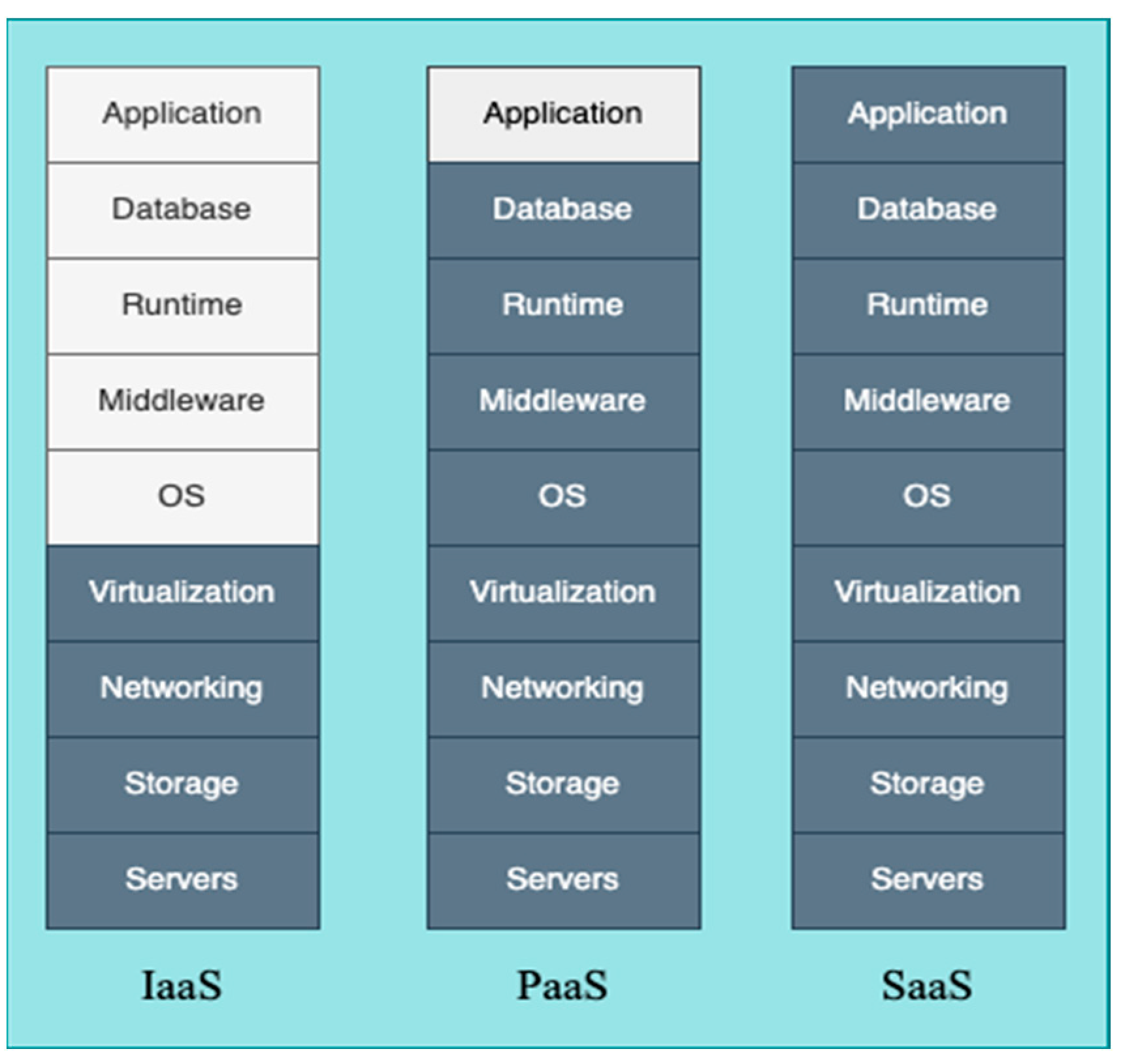
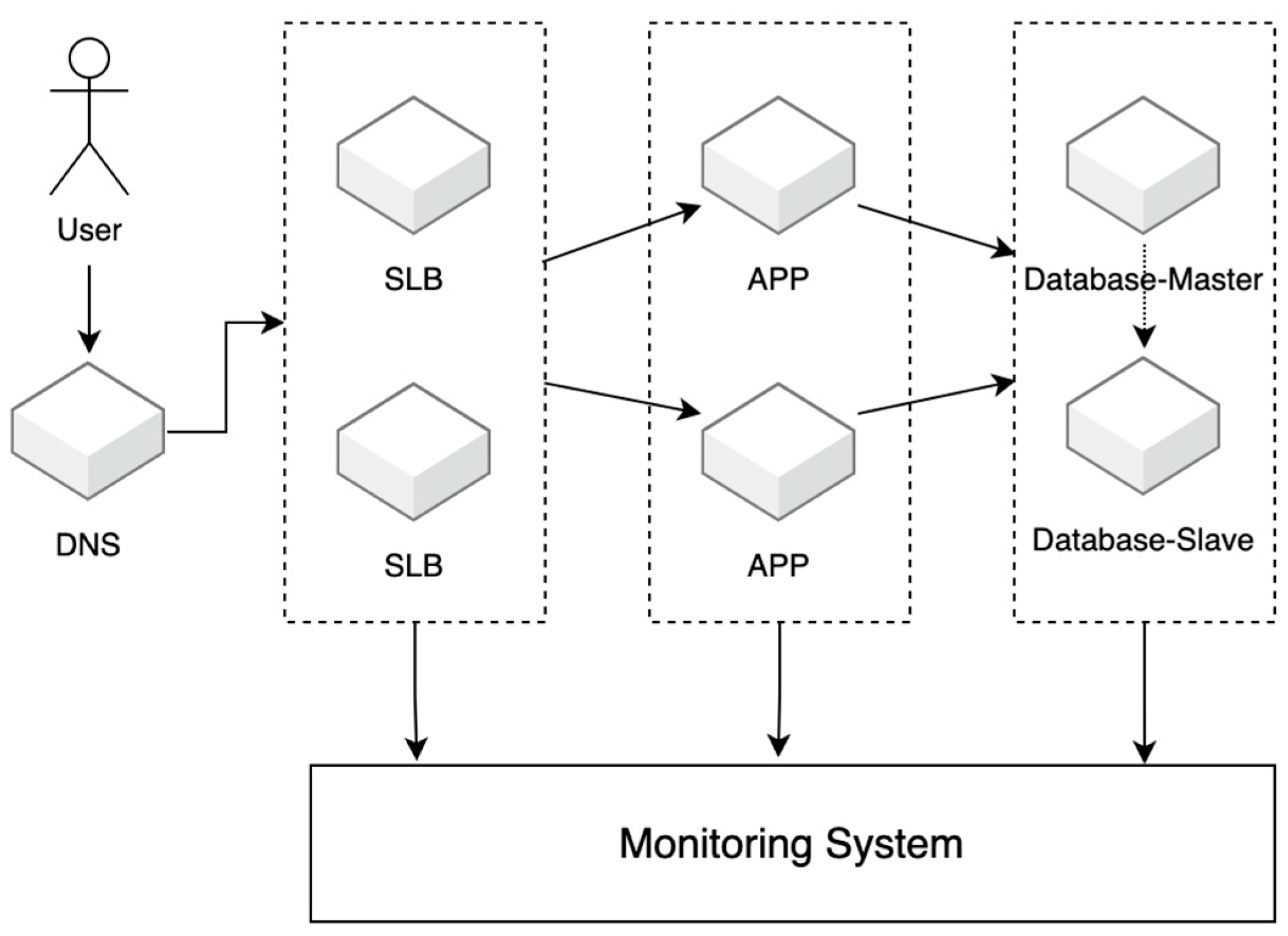


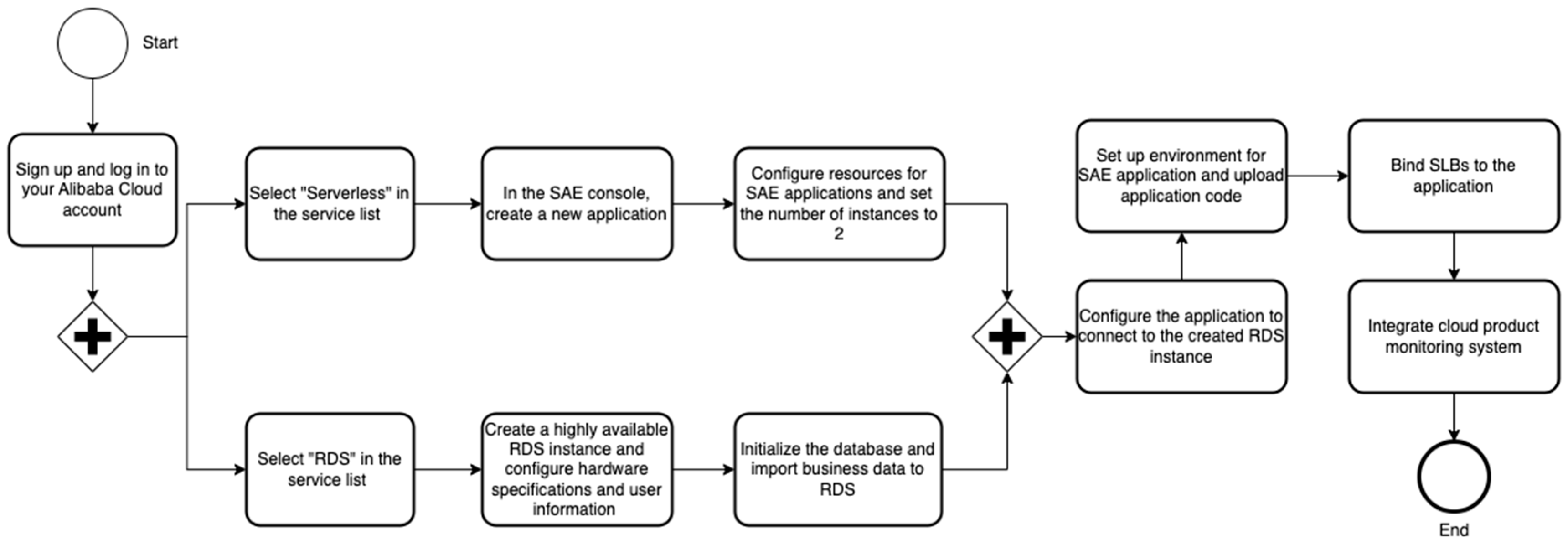

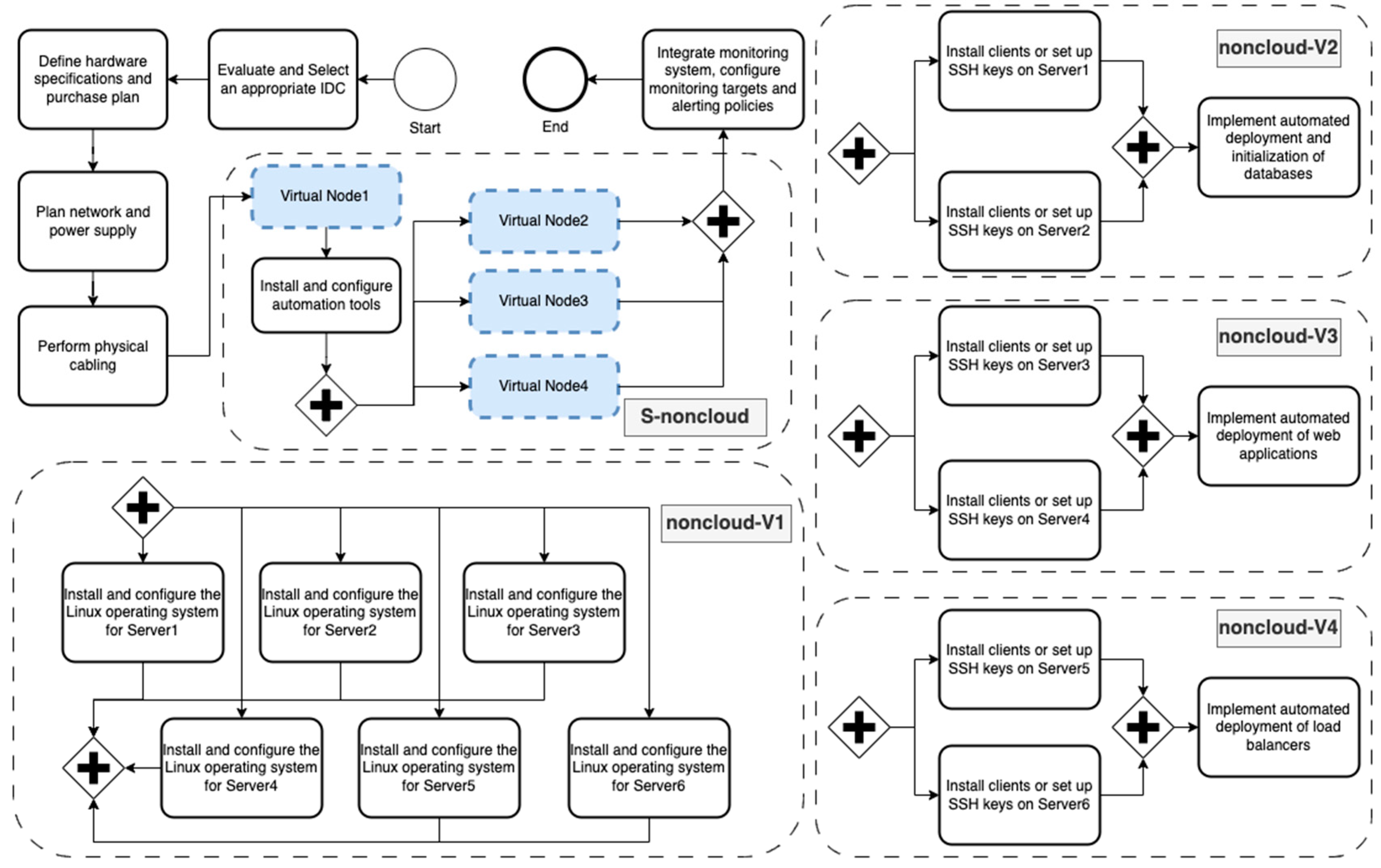
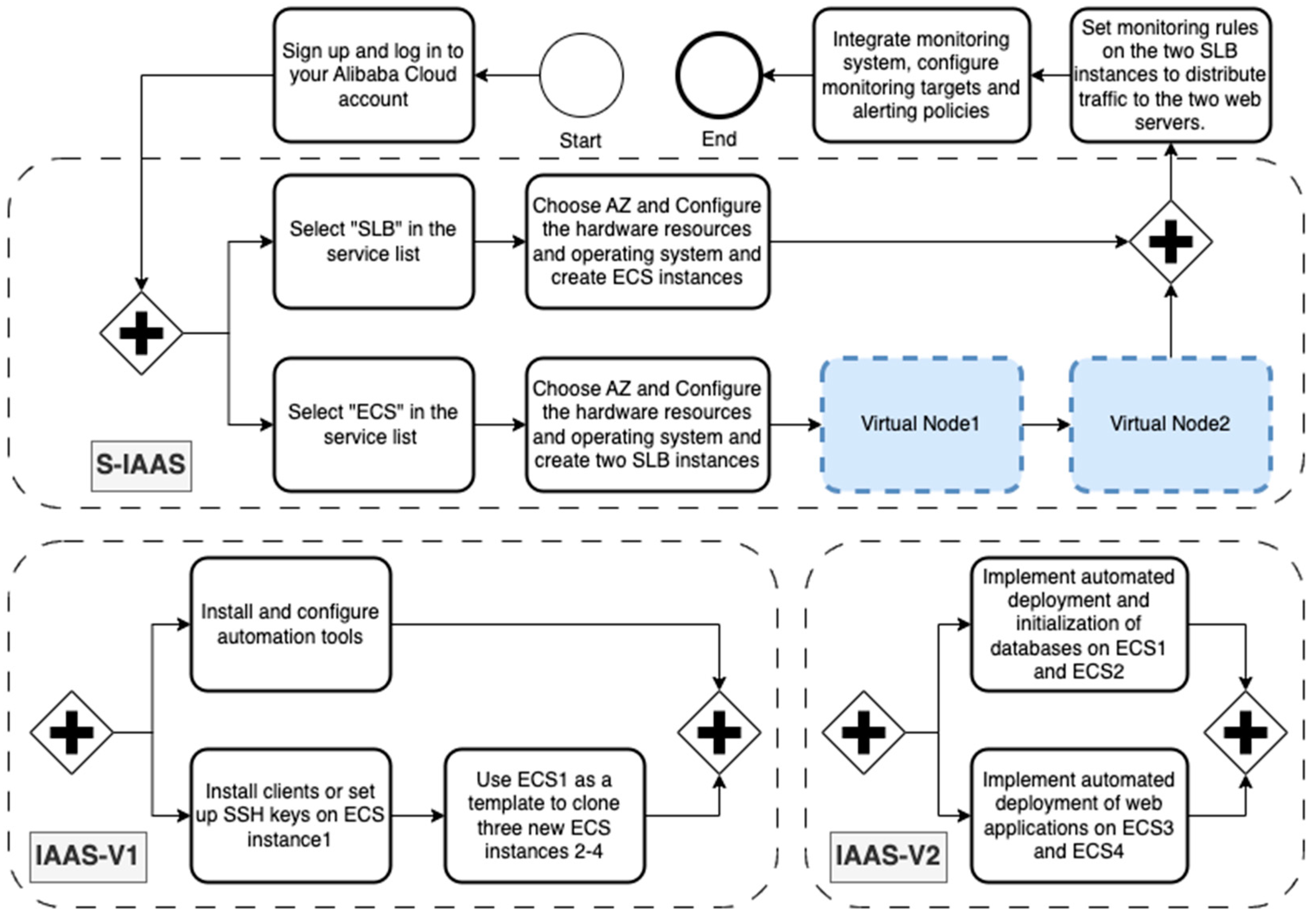


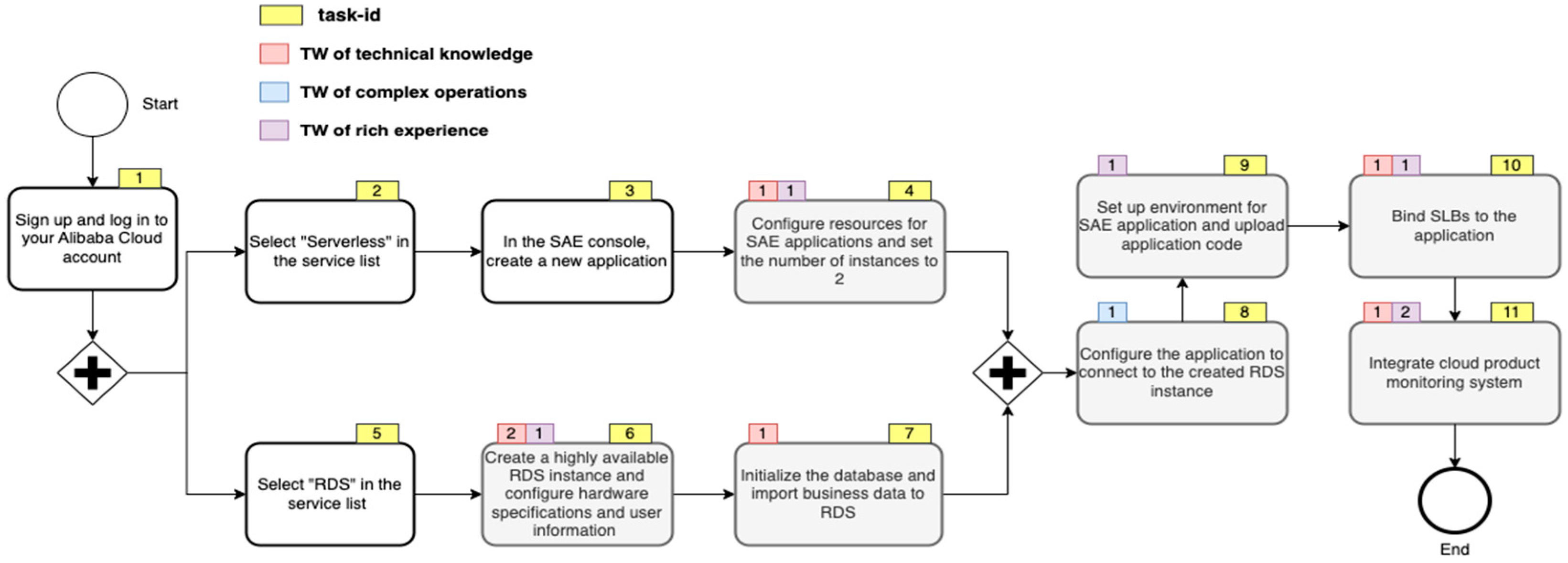


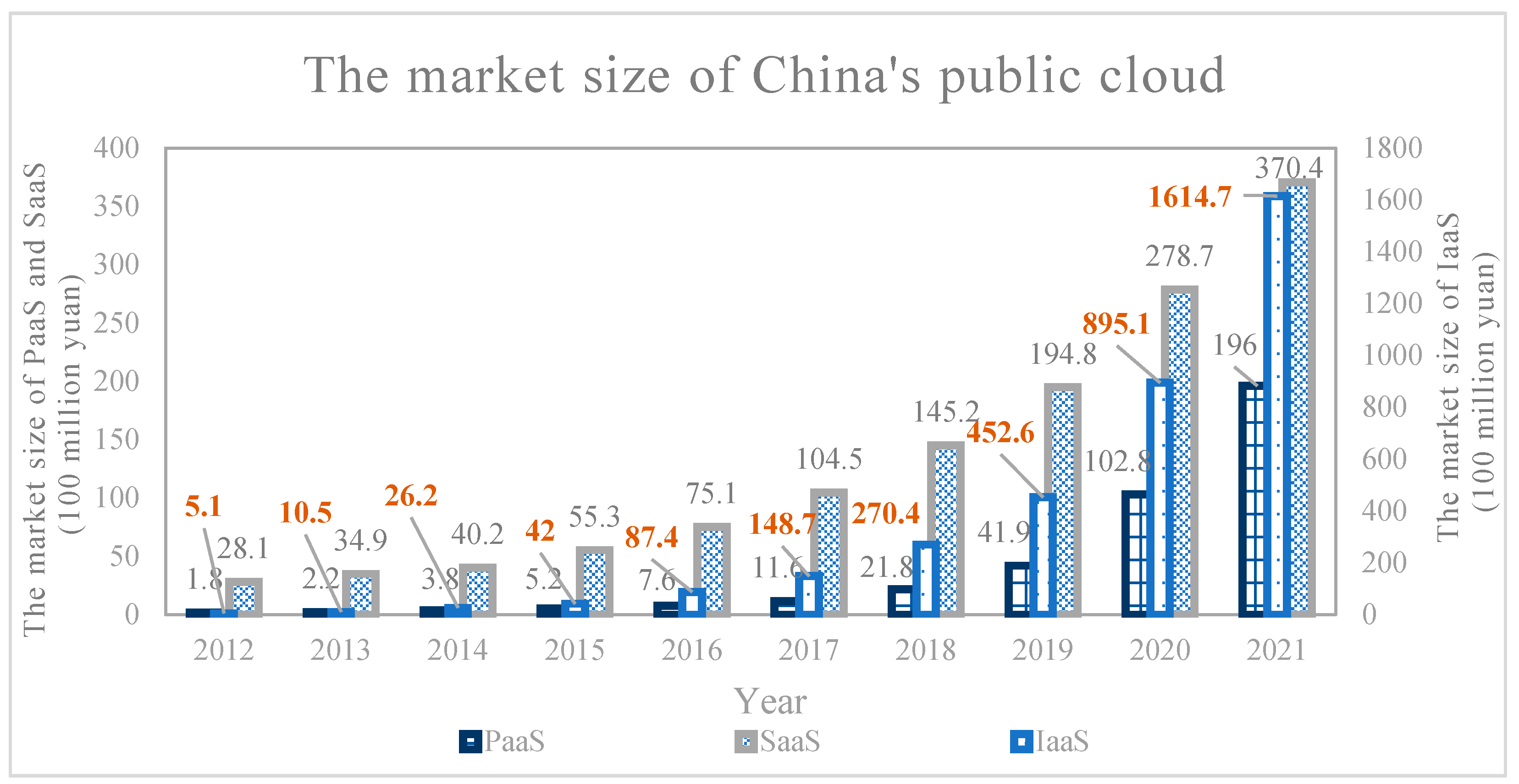
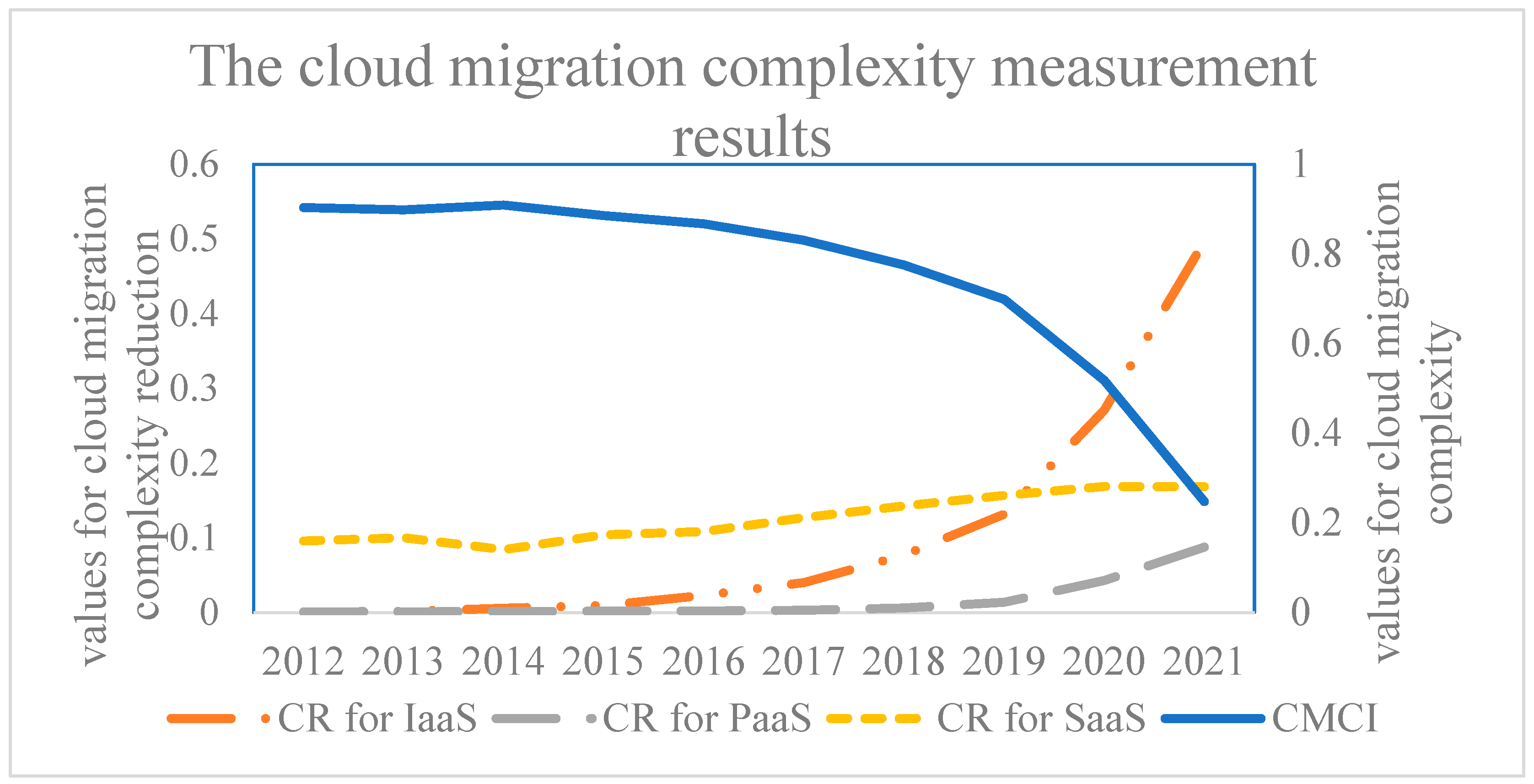
| Cloud Computing Level | RC (Relative Complexity of Cloud Migration) |
|---|---|
| Infrastructure as a Service (IaaS) | 0.329 |
| Platform as a Service (PaaS) | 0.0259 |
| Software as a Service (SaaS) | 0.0099 |
| Variable Type | Variable Name | Variables | Description |
|---|---|---|---|
| Dependent Variable | Enterprise’s Digitalization Level | dig | Indicator constructed in this study |
| Core Independent Variables | Cloud Migration Complexity Index (before/after classification) | cmci/cmci_tec | Indicator constructed in this study |
| Complexity Reduction Indicator of IaaS (before/after classification) | icr/icr_tech | Indicator constructed in this study | |
| Complexity Reduction Indicator of PaaS (before/after classification) | pcr/pcr_tec | Indicator constructed in this study | |
| Complexity Reduction Indicator of SaaS (before/after classification) | scr/scr_tec | Indicator constructed in this study | |
| Control Variables | Digital Background of Senior Executives | mdb | If any executive in the listed company has a digital background, then it is 1; otherwise, 0 |
| Equity Concentration | scr | Shareholding ratio of the largest shareholder (%) | |
| Net Profit Rate of Total Assets | roa | Net profit/total assets | |
| Return on Equity | roe | Net profit/net assets | |
| Asset–Liability Ratio | lev | Total liabilities/total assets | |
| Asset Structure | ast | (Net fixed assets + net inventory)/total assets | |
| Intangible Asset rate | iar | Net intangible assets/total assets | |
| Investment Expenditure Rate | invt | Cash paid for purchasing fixed assets, intangible assets, and other long-term assets/total assets | |
| Total Asset Growth Rate | tag | Total asset growth rate | |
| Total Operating Cost Growth rate | gcost | Total operating cost growth rate | |
| Logarithm of Per Capita GDP at the Prefecture-Level City | gdp | ln(Per capita regional GDP) |
| Variable | Obs | Mean | Std. Dev. | Min | Max |
|---|---|---|---|---|---|
| dig | 30,705 | 13.428 | 33.773 | 0 | 589 |
| cmci | 30,705 | 0.776 | 0.146 | 0.485 | 0.913 |
| cmci_tech | 30,705 | 0.708 | 0.226 | 0.248 | 0.909 |
| icd | 30,705 | 0.075 | 0.093 | 0.000 | 0.269 |
| pcd | 30,705 | 0.020 | 0.028 | 0.001 | 0.081 |
| scd | 30,705 | 0.129 | 0.030 | 0.082 | 0.165 |
| icd_tech | 30,705 | 0.139 | 0.171 | 0.000 | 0.497 |
| pcd_tech | 30,705 | 0.021 | 0.030 | 0.001 | 0.088 |
| scd_tech | 30,705 | 0.132 | 0.030 | 0.084 | 0.169 |
| lnngdp | 25,813 | 2.441 | 0.045 | 2.206 | 2.569 |
| tag | 30,704 | 0.213 | 0.810 | −0.972 | 47.927 |
| roa | 30,705 | 0.038 | 0.699 | −30.688 | 108.366 |
| roe | 30,602 | 0.040 | 2.807 | −186.557 | 281.989 |
| lev | 30,705 | 0.436 | 1.073 | −0.195 | 178.346 |
| ast | 29,958 | 0.347 | 0.178 | 0.000 | 0.962 |
| iar | 30,705 | 0.046 | 0.061 | 0.000 | 0.938 |
| mdb | 30,705 | 0.100 | 0.300 | 0.000 | 1.000 |
| invt | 30,671 | 0.048 | 0.048 | 0.000 | 0.642 |
| gcostr | 30,692 | 0.192 | 0.494 | −0.736 | 4.574 |
| SMEs | 30,705 | 0.253 | 0.435 | 0.000 | 1.000 |
| (1) | (2) | (3) | (4) | |
|---|---|---|---|---|
| Baseline | Baseline | IV | IV | |
| Dig | Dig | Dig | Dig | |
| cmci | −22.24 *** | −22.71 *** | ||
| (−17.02) | (−17.05) | |||
| cmci_tech | −13.79 *** | −14.62 *** | ||
| (−16.84) | [−17.04] | |||
| _cons | 31.01 *** | 23.60 *** | ||
| (20.37) | (17.46) | |||
| Control Variables | YES | YES | YES | YES |
| Kleibergen–Paap rk LM statistic | 2794.5 | 2815.9 | ||
| P-val for Kleibergen–Paap rk LM statistic | 0.00 | 0.00 | ||
| Cragg-Donald Wald F statistic | 13,878,136.7 | 6,124,746.7 | ||
| N | 29,319 | 29,319 | 29,319 | 29,319 |
| r2_a | 0.735 | 0.735 | 0.0500 | 0.0481 |
| (1) | (2) | (3) | (4) | (5) | (6) | |
|---|---|---|---|---|---|---|
| Dig | Dig | Dig | Dig | Dig | Dig | |
| icr | 35.83 *** | |||||
| (17.03) | ||||||
| icr_tech | 19.44 *** | |||||
| (17.03) | ||||||
| pcr | 119.8 *** | |||||
| (17.01) | ||||||
| pcr_tech | 111.3 *** | |||||
| (17.01) | ||||||
| scr | 128.7 *** | |||||
| (17.12) | ||||||
| scr_tech | 125.6 *** | |||||
| (17.12) | ||||||
| Control Variables | YES | YES | YES | YES | YES | YES |
| Kleibergen–Paap rk LM statistic | 2855.1 | 2855.1 | 2924.1 | 2924.1 | 2399.0 | 2399.0 |
| P-val for Kleibergen–Paap rk LM statistic | 0.000 | 0.000 | 0.000 | 0.000 | 0.000 | 0.000 |
| Cragg-Donald Wald F statistic | 1,839,546.4 | 1,839,546.4 | 475,381.2 | 475,381.2 | 91,694.9 | 91,694.9 |
| N | 29,319 | 29,319 | 29,319 | 29,319 | 29,319 | 29,319 |
| r2_a | 0.0444 | 0.0444 | 0.0359 | 0.0359 | 0.0709 | 0.0709 |
| (1) | (2) | (3) | (4) | |
|---|---|---|---|---|
| Dig | Dig | Dig | Dig | |
| cmci | −23.32 *** | −22.32 *** | ||
| (−6.86) | (−16.26) | |||
| cmci_tech | −15.02 *** | −14.36 *** | ||
| (−6.86) | (−16.26) | |||
| Control Variables | YES | YES | YES | YES |
| Kleibergen–Paap rk LM statistic | 696.3 | 2116.3 | 700.9 | 2133.0 |
| P-val for Kleibergen–Paap rk LM statistic | 0.000 | 0.000 | 0.000 | 0.000 |
| Cragg–Donald Wald F statistic | 3,835,989.0 | 9,652,778.5 | 1,634,202.8 | 4,303,845.2 |
| N | 7629 | 21,690 | 7629 | 21,690 |
| r2_a | 0.0508 | 0.0526 | 0.0492 | 0.0506 |
| (1) | (2) | (3) | (4) | (5) | (6) | |
|---|---|---|---|---|---|---|
| Dig | Dig | Dig | Dig | Dig | Dig | |
| icr | 36.86 *** | 35.16 *** | ||||
| (6.86) | (16.25) | |||||
| pcr | 165.9 *** | 117.4 *** | ||||
| (7.74) | (16.22) | |||||
| scr | 132.0 *** | 137.5 *** | ||||
| (6.97) | (16.74) | |||||
| Control Variables | YES | YES | YES | YES | YES | YES |
| Kleibergen–Paap rk LM statistic | 709.2 | 2163.6 | 688.8 | 2216.3 | 606.9 | 1771.6 |
| P-val for Kleibergen–Paap rk LM statistic | 0.000 | 0.000 | 0.000 | 0.000 | 0.000 | 0.000 |
| Cragg–Donald Wald F statistic | 470,933.0 | 1,319,177.2 | 39,359.4 | 349,791.4 | 23,980.2 | 229,300.0 |
| N | 7629 | 21,690 | 7629 | 21,690 | 7629 | 21,690 |
| r2_a | 0.0459 | 0.0466 | 0.0311 | 0.0376 | 0.0705 | 0.0743 |
| (1) | (2) | (3) | (4) | (5) | (6) | |
|---|---|---|---|---|---|---|
| Dig | Dig | Dig | Dig | Dig | Dig | |
| icr_tech | 19.99 *** | 19.07 *** | ||||
| (6.86) | (16.25) | |||||
| pcr_tech | 154.3 *** | 109.1 *** | ||||
| (7.74) | (16.22) | |||||
| scr_tech | 127.7 *** | 134.2 *** | ||||
| (6.89) | (16.74) | |||||
| Control variables | YES | YES | YES | YES | YES | YES |
| Kleibergen–Paap rk LM statistic | 709.2 | 2163.6 | 688.8 | 2216.3 | 607.3 | 1771.6 |
| P-val for Kleibergen–Paap rk LM statistic | 0.000 | 0.000 | 0.000 | 0.000 | 0.000 | 0.000 |
| Cragg–Donald Wald F statistic | 470,933.0 | 1,319,177.2 | 39,359.4 | 349,791.4 | 22,691.4 | 229,300.0 |
| N | 7629 | 21,690 | 7629 | 21,690 | 7629 | 21,690 |
| r2_a | 0.0459 | 0.0466 | 0.0311 | 0.0376 | 0.0704 | 0.0743 |
Disclaimer/Publisher’s Note: The statements, opinions and data contained in all publications are solely those of the individual author(s) and contributor(s) and not of MDPI and/or the editor(s). MDPI and/or the editor(s) disclaim responsibility for any injury to people or property resulting from any ideas, methods, instructions or products referred to in the content. |
© 2024 by the authors. Licensee MDPI, Basel, Switzerland. This article is an open access article distributed under the terms and conditions of the Creative Commons Attribution (CC BY) license (https://creativecommons.org/licenses/by/4.0/).
Share and Cite
Wen, W.; Zhang, C.; Ye, Q. Beyond Barriers: Constructing the Cloud Migration Complexity Index for China’s Digital Transformation. J. Theor. Appl. Electron. Commer. Res. 2024, 19, 2239-2268. https://doi.org/10.3390/jtaer19030109
Wen W, Zhang C, Ye Q. Beyond Barriers: Constructing the Cloud Migration Complexity Index for China’s Digital Transformation. Journal of Theoretical and Applied Electronic Commerce Research. 2024; 19(3):2239-2268. https://doi.org/10.3390/jtaer19030109
Chicago/Turabian StyleWen, Weiwei, Chenglei Zhang, and Qin Ye. 2024. "Beyond Barriers: Constructing the Cloud Migration Complexity Index for China’s Digital Transformation" Journal of Theoretical and Applied Electronic Commerce Research 19, no. 3: 2239-2268. https://doi.org/10.3390/jtaer19030109




